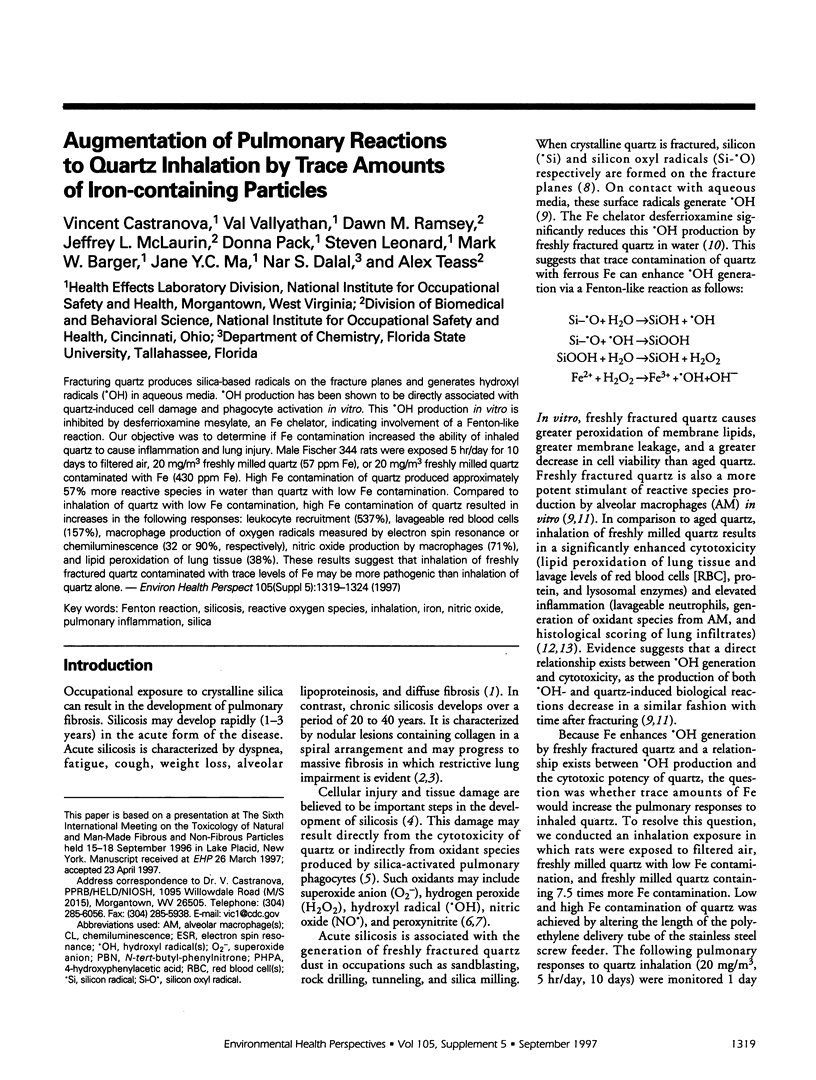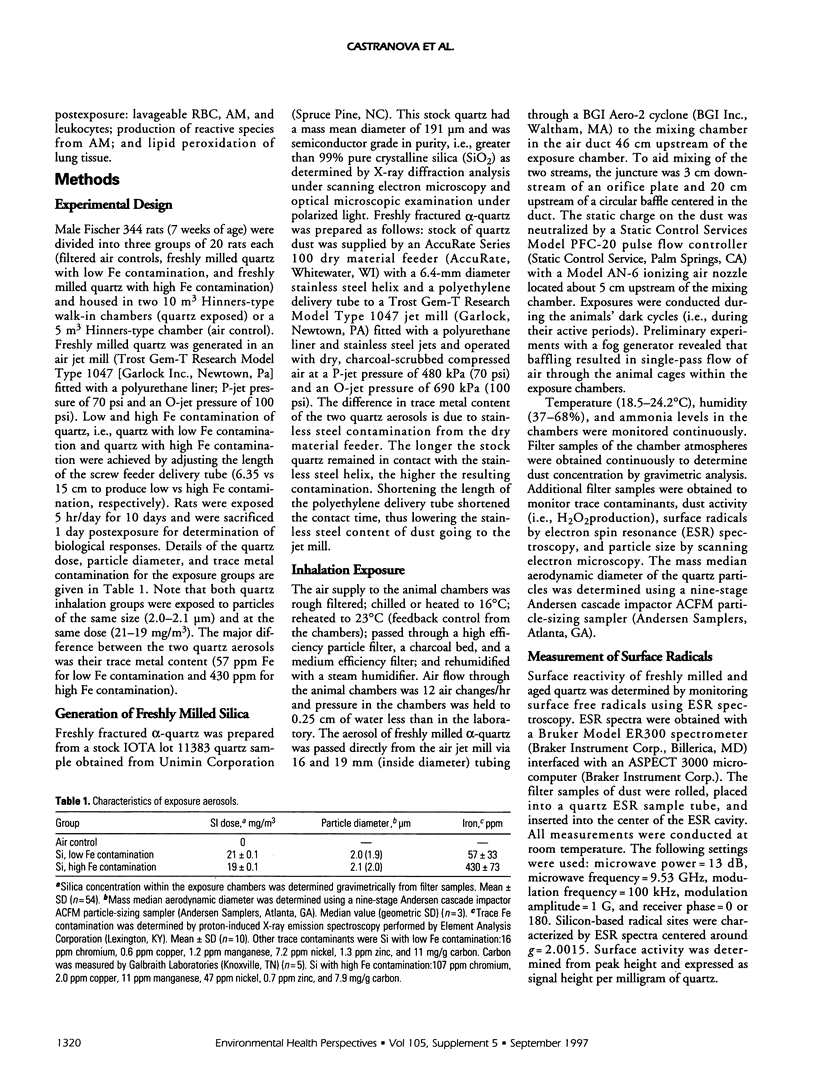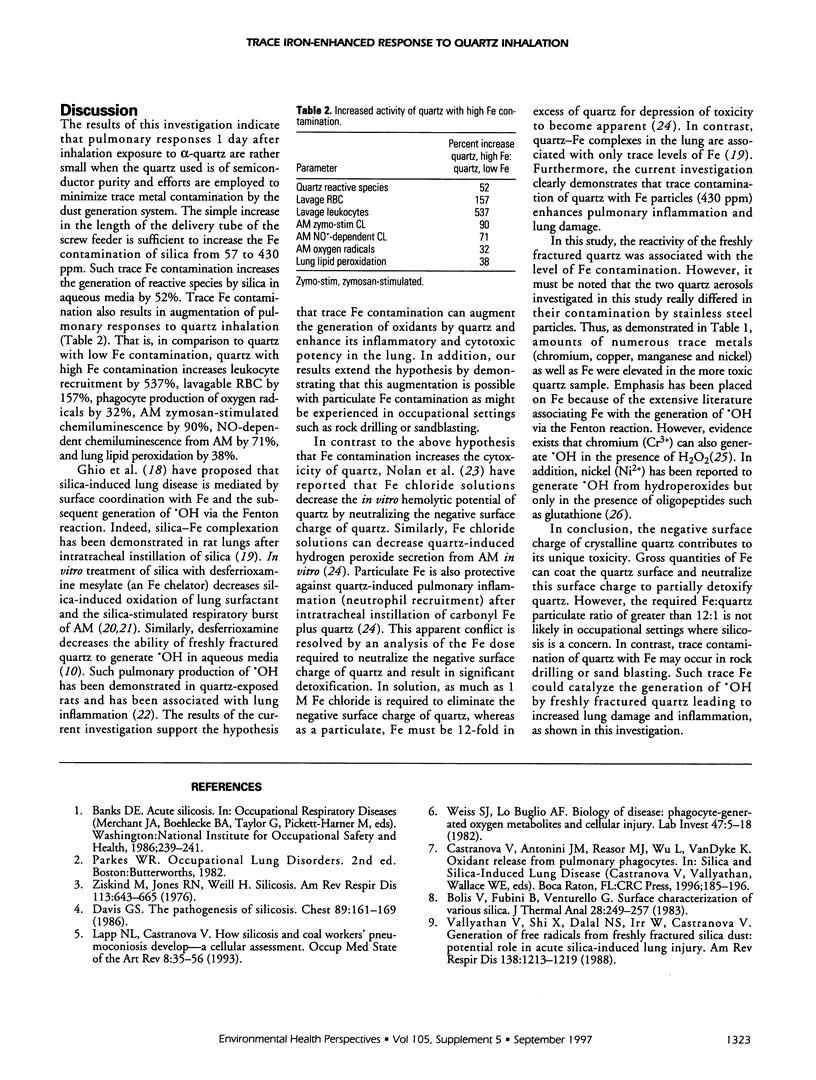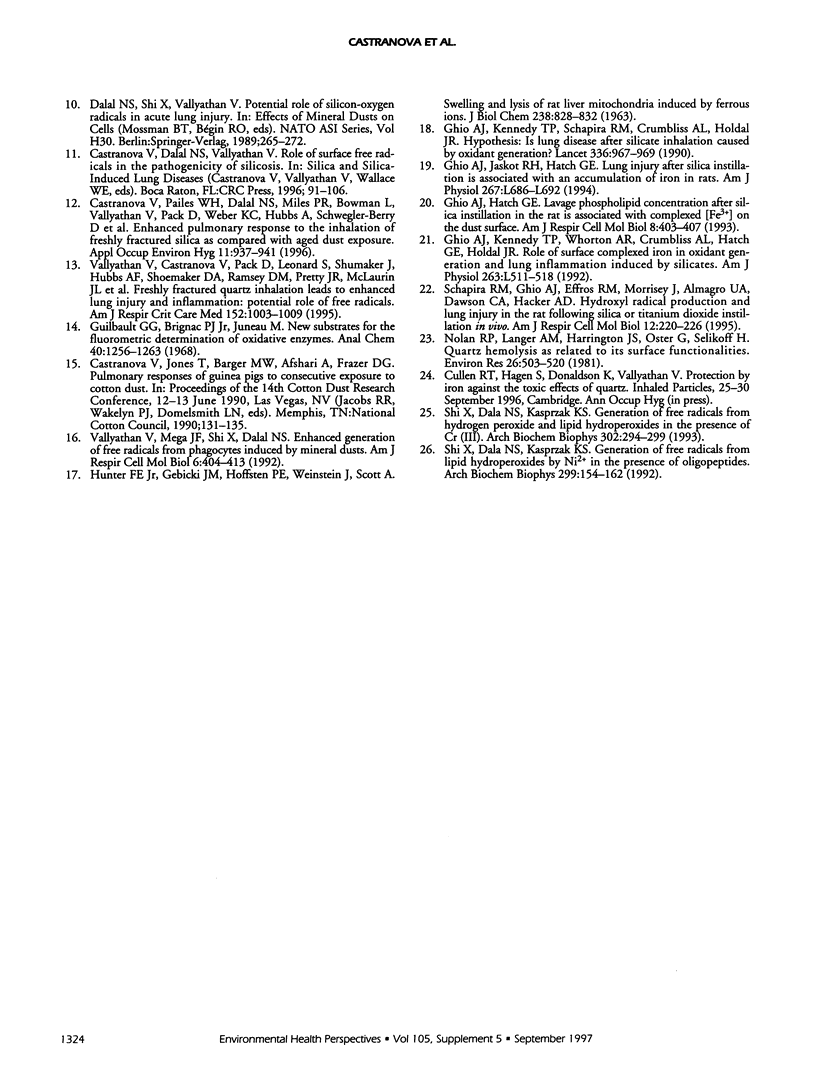Abstract
Fracturing quartz produces silica-based radicals on the fracture planes and generates hydroxyl radicals (.OH) in aqueous media. .OH production has been shown to be directly associated with quartz-induced cell damage and phagocyte activation in vitro. This .OH production in vitro is inhibited by desferrioxamine mesylate, an Fe chelator, indicating involvement of a Fenton-like reaction. Our objective was to determine if Fe contamination increased the ability of inhaled quartz to cause inflammation and lung injury. Male Fischer 344 rats were exposed 5 hr/day for 10 days to filtered air, 20 mg/m3 freshly milled quartz (57 ppm Fe), or 20 mg/m3 freshly milled quartz contaminated with Fe (430 ppm Fe). High Fe contamination of quartz produced approximately 57% more reactive species in water than quartz with low Fe contamination. Compared to inhalation of quartz with low Fe contamination, high Fe contamination of quartz resulted in increases in the following responses: leukocyte recruitment (537%), lavageable red blood cells (157%), macrophage production of oxygen radicals measured by electron spin resonance or chemiluminescence (32 or 90%, respectively), nitric oxide production by macrophages (71%), and lipid peroxidation of lung tissue (38%). These results suggest that inhalation of freshly fractured quartz contaminated with trace levels of Fe may be more pathogenic than inhalation of quartz alone.
Full text
PDF





Selected References
These references are in PubMed. This may not be the complete list of references from this article.
- Ghio A. J., Hatch G. E. Lavage phospholipid concentration after silica instillation in the rat is associated with complexed [Fe3+] on the dust surface. Am J Respir Cell Mol Biol. 1993 Apr;8(4):403–407. doi: 10.1165/ajrcmb/8.4.403. [DOI] [PubMed] [Google Scholar]
- Ghio A. J., Jaskot R. H., Hatch G. E. Lung injury after silica instillation is associated with an accumulation of iron in rats. Am J Physiol. 1994 Dec;267(6 Pt 1):L686–L692. doi: 10.1152/ajplung.1994.267.6.L686. [DOI] [PubMed] [Google Scholar]
- Ghio A. J., Kennedy T. P., Schapira R. M., Crumbliss A. L., Hoidal J. R. Hypothesis: is lung disease after silicate inhalation caused by oxidant generation? Lancet. 1990 Oct 20;336(8721):967–969. doi: 10.1016/0140-6736(90)92421-d. [DOI] [PubMed] [Google Scholar]
- Ghio A. J., Kennedy T. P., Whorton A. R., Crumbliss A. L., Hatch G. E., Hoidal J. R. Role of surface complexed iron in oxidant generation and lung inflammation induced by silicates. Am J Physiol. 1992 Nov;263(5 Pt 1):L511–L518. doi: 10.1152/ajplung.1992.263.5.L511. [DOI] [PubMed] [Google Scholar]
- Guilbault G. G., Brignac P. J., Jr, Juneau M. New substrates for the fluorometric determination of oxidative enzymes. Anal Chem. 1968 Jul;40(8):1256–1263. doi: 10.1021/ac60264a027. [DOI] [PubMed] [Google Scholar]
- HUNTER F. E., Jr, GEBICKI J. M., HOFFSTEN P. E., WEINSTEIN J., SCOTT A. Swelling and lysis of rat liver mitochondria induced by ferrous ions. J Biol Chem. 1963 Feb;238:828–835. [PubMed] [Google Scholar]
- Lapp N. L., Castranova V. How silicosis and coal workers' pneumoconiosis develop--a cellular assessment. Occup Med. 1993 Jan-Mar;8(1):35–56. [PubMed] [Google Scholar]
- Lefcoe N. M. Passive smoking. Acute effects in asthma. Chest. 1986 Feb;89(2):161–162. doi: 10.1378/chest.89.2.161. [DOI] [PubMed] [Google Scholar]
- Nolan R. P., Langer A. M., Harington J. S., Oster G., Selikoff I. J. Quartz hemolysis as related to its surface functionalities. Environ Res. 1981 Dec;26(2):503–520. doi: 10.1016/0013-9351(81)90226-7. [DOI] [PubMed] [Google Scholar]
- Schapira R. M., Ghio A. J., Effros R. M., Morrisey J., Almagro U. A., Dawson C. A., Hacker A. D. Hydroxyl radical production and lung injury in the rat following silica or titanium dioxide instillation in vivo. Am J Respir Cell Mol Biol. 1995 Feb;12(2):220–226. doi: 10.1165/ajrcmb.12.2.7865220. [DOI] [PubMed] [Google Scholar]
- Shi X., Dalal N. S., Kasprzak K. S. Generation of free radicals from hydrogen peroxide and lipid hydroperoxides in the presence of Cr(III). Arch Biochem Biophys. 1993 Apr;302(1):294–299. doi: 10.1006/abbi.1993.1213. [DOI] [PubMed] [Google Scholar]
- Shi X., Dalal N. S., Kasprzak K. S. Generation of free radicals from lipid hydroperoxides by Ni2+ in the presence of oligopeptides. Arch Biochem Biophys. 1992 Nov 15;299(1):154–162. doi: 10.1016/0003-9861(92)90257-w. [DOI] [PubMed] [Google Scholar]
- Vallyathan V., Castranova V., Pack D., Leonard S., Shumaker J., Hubbs A. F., Shoemaker D. A., Ramsey D. M., Pretty J. R., McLaurin J. L. Freshly fractured quartz inhalation leads to enhanced lung injury and inflammation. Potential role of free radicals. Am J Respir Crit Care Med. 1995 Sep;152(3):1003–1009. doi: 10.1164/ajrccm.152.3.7663775. [DOI] [PubMed] [Google Scholar]
- Vallyathan V., Mega J. F., Shi X., Dalal N. S. Enhanced generation of free radicals from phagocytes induced by mineral dusts. Am J Respir Cell Mol Biol. 1992 Apr;6(4):404–413. doi: 10.1165/ajrcmb/6.4.404. [DOI] [PubMed] [Google Scholar]
- Vallyathan V., Shi X. L., Dalal N. S., Irr W., Castranova V. Generation of free radicals from freshly fractured silica dust. Potential role in acute silica-induced lung injury. Am Rev Respir Dis. 1988 Nov;138(5):1213–1219. doi: 10.1164/ajrccm/138.5.1213. [DOI] [PubMed] [Google Scholar]
- Weiss S. J., LoBuglio A. F. Phagocyte-generated oxygen metabolites and cellular injury. Lab Invest. 1982 Jul;47(1):5–18. [PubMed] [Google Scholar]
- Ziskind M., Jones R. N., Weill H. Silicosis. Am Rev Respir Dis. 1976 May;113(5):643–665. doi: 10.1164/arrd.1976.113.5.643. [DOI] [PubMed] [Google Scholar]


